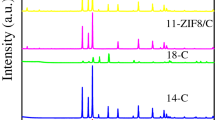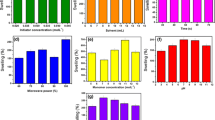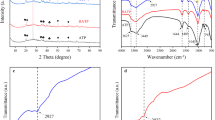Abstract
An environmentally friendly and low-cost chitosan-containing polysaccharide (CP) composite ZIF-8/CP was designed and prepared based on the difficulty of separating the traditional adsorbent from the water phase. ZIF-8/CP was synthesized through in-situ growth approach. The physical, chemical and structure properties of ZIF-8/CP were determined through a series of characterization methods, including SEM, FT-IR and PXRD. The effects of touch time, pH, temperature, and co-existing ions on adsorption were assessed. In addition, kinetics, isotherms of adsorption and thermodynamics were examined. The data of isotherms for adsorption indicated that the adsorption of ZIF-8/CP on MG was similar to the Langmuir model, with a maximum adsorption capacity of 1428.57 mg/g. Moreover, the kinetic parameters were consistent with the pseudo-2nd-order equation. Thermodynamic studies (ΔG < 0, ΔH > 0) demonstrated a heat-absorbing and spontaneous adsorption process. Our study reveals that ZIF-8/CP has good adsorption properties and environmental properties.








Similar content being viewed by others
Data availability
Data will be made available on request.
Change history
18 February 2024
The authorship of this article has been corrected.
14 February 2024
A Correction to this paper has been published: https://doi.org/10.1007/s42823-024-00698-1
References
Xue Y, Xiang P, Wang H, Jiang Y, Long Y, Lian H et al (2019) Mechanistic insights into selective adsorption and separation of multicomponent anionic dyes using magnetic zeolite imidazolate framework-67 composites. J Mol Liq 296:111990. https://doi.org/10.1016/j.molliq.2019.111990
Pan B, Wu Y, Rhimi B, Qin J, Huang Y, Yuan M, Wang C (2021) Oxygen-doping of ZnIn2S4 nanosheets towards boosted photocatalytic CO2 reduction. J Energy Chem 57:1–9. https://doi.org/10.1016/j.jechem.2020.08.024
Pan B, Zhou L, Qin J, Wang C, Ma X, Sharma V (2022) Oxidation of micropollutants by visible light active graphitic carbon nitride and ferrate(VI): Delineating the role of surface delocalized electrons. Chemosphere 307:135886. https://doi.org/10.1016/j.chemosphere.2022.135886
Katheresan V, Kansedo J, Lau S (2018) Efficiency of various recent wastewater dye removal methods, a review. J Environ Chem Eng 6:4676–4697. https://doi.org/10.1016/j.jece.2018.06.060
Chandanshive V, Kadam S, Khandare R, Kurade M, Jeon B, Jadhav J, Govindwar S (2018) In situ phytoremediation of dyes from textile wastewater using garden ornamental plants, effect on soil quality and plant growth. Chemosphere 210:968–976. https://doi.org/10.1016/j.chemosphere.2018.07.064
Dong J, Xu C, Wang H, Xiao Z, Gee S, Li Z et al (2014) Enhanced sensitive immunoassay: noncompetitive phage anti-immune complex assay for the determination of malachite green and leucomalachite green. J Agr Food Chem 62:8752–8758. https://doi.org/10.1021/jf5019824
Zhang F, Wei Z, Zhang W, Cui H (2017) Effective adsorption of malachite green using magnetic barium phosphate composite from aqueous solution. Spectrochim Acta A 182:116–122. https://doi.org/10.1016/j.saa.2017.03.066
Mall I, Srivastava V, Agarwal N, Mishra I (2005) Adsorptive removal of malachite green dye from aqueous solution by bagasse fly ash and activated carbon-kinetic study and equilibrium isotherm analyses. Colloid Surf A 264:17–28. https://doi.org/10.1016/j.colsurfa.2005.03.027
Ghaedi M, Jah A, Khodadoust S, Sahrael R, Daneshfar A, Mihandoost A, Purkait M (2012) Cadmium telluride nanoparticles loaded on activated carbon as adsorbent for removal of sunset yellow. Spectrochim Acta A 90(5):22–27. https://doi.org/10.1016/j.saa.2011.12.064
Lou J, Fu Q, Yu L, Yuan H, Zhao J, Wang L et al (2022) Highly effective removal of Pb2+ from wastewater by nickel-based metal organic framework. J Solid State Chem 315:123535. https://doi.org/10.1016/j.jssc.2022.123535
Fu Q, Shi D, Mo C, Lou J, Zhou S, Zha L et al (2022) Adsorption behavior of methylene blue on regenerable composite Cu-BTC@AG. J Solid State Chem 311:123100. https://doi.org/10.1016/j.jssc.2022.123100
Fu Q, Lou J, Zhang R, Peng L, Zhou S, Yan W et al (2021) Highly effective and fast removal of Congo red from wastewater with metal-organic framework Fe-MIL-88NH2. J Solid State Chem 294:121836. https://doi.org/10.1016/j.jssc.2020.121836
Tang Z, Zhu F, Zhou J, Chen W, Wang K, Liu M et al (2022) Monolithic NF@ZnO/Au@ZIF-8 photocatalyst with strong photo-thermal-magnetic coupling and selective-breathing effects for boosted conversion of CO2 to CH4. Appl Catal B 309:121267. https://doi.org/10.1016/j.apcatb.2022.121267
Jadhav H, Bandal H, Ramakrishna S, Kim H (2022) Critical review, recent updates on zeolitic imidazolate framework-67 (ZIF-67) and its derivatives for electrochemical water splitting. Adv Mater 34:2107072. https://doi.org/10.1002/adma.202107072
Tran V, Le T, Vo T, Nguyen P, Don T, Vasseghian Y et al (2022) Experimental and computational investigation of a green Knoevenagel condensation catalyzed by zeolitic imidazolate framework-8. Environ Res 204:112364. https://doi.org/10.1016/j.envres.2021.112364
Xue W, Yang G, Bi S, Zhang J, Hou Z (2021) Construction of caterpillar-like hierarchically structured Co/MnO/CNTs derived from MnO2/ZIF-8@ZIF-67 for electromagnetic wave absorption. Carbon 173(48):521–527. https://doi.org/10.1016/j.carbon.2020.11.016
Li Y, Kim J, Wang J, Liu N, Bando Y, Alshehri A et al (2018) High performance capacitive deionization using modified ZIF-8-derived, N-doped porous carbon with improved conductivity. Nanoscale 10(31):14852–14859. https://doi.org/10.1039/C8NR02288G
Liu J, Chen Y, Hu Y, Zhang Y, Zhang G, Wang S, Zhang L (2022) A novel metal-organic framework-derived ZnO@ZIF-8 adsorbent with high efficiency for Pb (II) from solution: performance and mechanisms. J Mol Liq 356:119057. https://doi.org/10.1016/j.molliq.2022.119057
Li D, Xu F (2021) Removal of Cu (II) from aqueous solutions using ZIF-8@GO composites. J Solid State Chem 302:122406. https://doi.org/10.1016/j.jssc.2021.122406
Lee H, Cho W, Oh M (2012) Advanced fabrication of metal-organic frameworks: template-directed formation of polystyrene@ZIF-8 core-shell and hollow ZIF-8 microspheres. Chem Commun 48:221–223. https://doi.org/10.1039/c1cc16213f
Zhao Y, Ni X, Ye S, Gu Z, Ngai T et al (2020) A smart route for encapsulating Pd nanoparticles into a ZIF-8 hollow microsphere and their superior catalytic properties. Langmuir 36:2037–2043. https://doi.org/10.1021/acs.langmuir.9b03731
Bahmani E, Koushkbaghi S, Darabi M, ZabihiSahebi A, Askari A, Irani M (2019) Fabrication of novel chitosan-g-PNVCL/ZIF-8 composite nanofibers for adsorption of Cr(VI), As(V) and phenol in a single and ternary systems. Carbohyd Polym 224:115148. https://doi.org/10.1016/j.carbpol.2019.115148
Sutirman Z, Rahim E, Sanagi M, Karim K, Ibrahim W (2020) New efficient chitosan derivative for Cu(II) ions removal: characterization and adsorption performance. Int J Biol Macromol 153:513–522. https://doi.org/10.1016/j.ijbiomac.2020.03.015
Wang G, Wang J, Chen Z, Hu J (2022) Metal-organic framework grown in situ on chitosan microspheres as robust host of palladium for heterogeneous catalysis: Suzuki reaction and the p-nitrophenol reduction. Int J Biol Macromol 206:232–241. https://doi.org/10.1016/j.ijbiomac.2022.02.010
Wang Y, Dai X, Zhan Y, Ding X, Wang X (2019) In situ growth of ZIF-8 nanoparticles on chitosan to form the hybrid nanocomposites for high-efficiency removal of Congo red. Int J Biol Macromol 137:77–86. https://doi.org/10.1016/j.ijbiomac.2019.06.195
Zheng X, Zheng H, Xiong Z, Zhao R, Liu Y, Zhao C, Zheng C (2020) Novel anionic polyacrylamide-modify-chitosan magnetic composite nanoparticles with excellent adsorption capacity for cationic dyes and pH independent adsorption capability for metal ions. Chem Eng J 392:123706. https://doi.org/10.1016/j.cej.2019.123706
Wang M, Zhang J, Yi X, Zhao X, Liu B, Liu X (2020) Nitrogen-doped hierarchical porous carbon derived from ZIF-8 supported on carbon aerogels with advanced performance for supercapacitor. Appl Surf Sci 507:145166. https://doi.org/10.1016/j.apsusc.2019.145166
Liu L, Ma Y, Yang W, Chen C, Li M, Lin D, Pan Q (2020) Reusable ZIF-8@chitosan sponge for the efficient and selective removal of congo red. New J Chem 44:15459. https://doi.org/10.1039/D0NJ02699A
Zhou L, Li N, Jin X, Owens G, Chen Z (2020) A new nFe@ZIF-8 for the removal of Pb(II) from wastewater by selective adsorption and reduction. J Colloid Interf Sci 565:167–176. https://doi.org/10.1016/j.jcis.2020.01.014
Mahmoodi N, Oveisi M, Taghizadeh A, Taghizadeh M (2020) Synthesis of pearl necklace-like ZIF-8@chitosan/PVA nanofiber with synergistic effect for recycling aqueous dye removal. Carbohyd Polym 227:115364. https://doi.org/10.1016/j.carbpol.2019.115364
Nie J, Wang Z, Zhang K, Hu Q (2015) Biomimetic multi-layered hollow chitosan-tripolyphosphate rod with excellent mechanical performance. RSC Adv 47(5):37346–37352. https://doi.org/10.1039/C5RA00936G
Su Z, Zhang M, Lu Z, Song S, Zhao Y, Hao Y (2018) Functionalization of cellulose fiber by in situ growth of zeolitic imidazolate framework-8 (ZIF-8) nanocrystals for preparing a cellulose-based air filter with gas adsorption ability. Cellulose 25(3):1997–2008. https://doi.org/10.1007/s10570-018-1696-4
Ma S, Zhang M, Nie J, Yang B, Song S, Lu P (2018) Multifunctional cellulose-based air filters with high loadings of metal-organic frameworks prepared by in situ growth method for gas adsorption and antibacterial applications. Cellulose 25(10):5999–6010. https://doi.org/10.1007/s10570-018-1982-1
Song X, Goh K, Wang K (2019) The equilibrium and fixed-bed study of malachite green adsorption on chitosan hydrogels. Water Sci Technol 79:1571–1579. https://doi.org/10.2166/wst.2019.160
Zhao L, Lv W, Hou J, Li Y, Duan J, Ai S (2020) Synthesis of magnetically recyclable g-C3N4/Fe3O4/ZIF-8 nanocomposites for excellent adsorption of malachite green. Microchem J 152:104425. https://doi.org/10.1016/j.microc.2019.104425
Fu Q, Zhou S, Wu P, Hu J, Lou J, Du B et al (2022) Regenerable zeolitic imidazolate frameworks@agarose (ZIF-8@AG) composite for highly efficient adsorption of Pb(II) from water. J Solid State Chem 307:122823. https://doi.org/10.1016/j.jssc.2021.122823
Fu Q, Shi D, Mo C, Lou J, Zhou S, Zha L et al (2022) Adsorption behavior of methylene blue on regenerable composite Cu-BTC@AG. J Solid State Chem 311:123100. https://doi.org/10.2139/ssrn.4010423
Choudhary M, Kumar R, Neogi S et al (2020) Activated biochar derived from Opuntia ficus-indica for the efficient adsorption of malachite green dye, Cu2+ and Ni2+ from water. J Hazard Mater 392:122441. https://doi.org/10.1016/j.jhazmat.2020.122441
Zheng C, Zheng H, Wang Y, Wang Y, Qu W, An Q, Liu Y et al (2018) Synthesis of novel modified magnetic chitosan particles and their adsorption performance toward Cr(VI). Bioresour Technol 267:1–8. https://doi.org/10.1016/j.biortech.2018.06.113
Eltaweil A, Mohamed H, El-Monaem E, El-Subruiti G (2020) Mesoporous magnetic biochar composite for enhanced adsorption of malachite green dye: characterization, adsorption kinetics, thermodynamics and isotherms. Adv Powder Technol 31:1253–1263. https://doi.org/10.1016/j.apt.2020.01.005
Gupta K, Khatri O (2017) Reduced graphene oxide as an effective adsorbent for removal of malachite green dye: Plausible adsorption pathways. J Colloid Interface Sci 501:11–21. https://doi.org/10.1016/j.jcis.2017.04.035
Tang H, Zhou W, Zhang L (2012) Adsorption isotherms and kinetics studies of malachite green on chitin hydrogels. J Hazard Mater 209:218–225. https://doi.org/10.1016/j.jhazmat.2012.01.010
Bekçi Z, Ozveri C, Seki Y, Yurdakoç K (2008) Sorption of malachite green on chitosan bead. J Hazard Mater 154(1–3):254–261. https://doi.org/10.1016/j.jhazmat.2007.10.021
Onder A, Kıvanç M, Durmuş S, Ilgin P, Ozay H, Ozay O (2022) Adsorption of malachite green from aqueous solution using hydroxyethyl starch hydrogel improved by graphene oxide. J Polym Environ 30(7):2928–2942. https://doi.org/10.1007/s10924-022-02410-8
Altintig E, Yenigun M, Sar A, Altundag H, Saleh T (2021) Facile synthesis of zinc oxide nanoparticles loaded activatedcarbon as an eco-friendly adsorbent for ultra-removal of malachite green from water. Environ Technol Inno 21(1):101305. https://doi.org/10.1016/j.eti.2020.101305
Shah H, Ahmad K, H. Naseem H, Parveen S, Aziz T, (2021) Water stable graphene oxide metal-organic frameworks composite (ZIF-67@GO) for efficient removal of malachite green from water. Food Chem Toxicol 154:112312. https://doi.org/10.1016/j.fct.2021.112312
Fouda A, Morsi M, Mogy T (2017) Studies on the inhibition of carbon steel corrosion in hydrochloric acid solution by expired Carvedilol drug. Green Chem Lett Rev 10(4):336–345. https://doi.org/10.1080/17518253.2017.1380236
Acknowledgements
This project was supported by Youth Scientific and Technological Talent Growth Project of Education Department of Guizhou Province (Qianjiaohe KY[2022]004), Sixth Batch of Guizhou Province High-level Innovative Talent Training Program[2022], Scientific Research Funds of Guiyang University (GYU-KY-[2023]), Innovation Team for Efficient and High-Value Utilisation of Biomass Resources (Qianjiaohe KY[2023]082), Characteristic Key Laboratory of Colleges and Universities of Guizhou Province (Qianjiaohe KY[2018]005), Innovation and Entrepreneurship Training Program for Undergraduates in Guizhou Province (S202010976052).
Author information
Authors and Affiliations
Corresponding author
Ethics declarations
Conflict of interest
The authors declare that they have no known competing financial interests or personal relationships that could have appeared to influence the work reported in this paper.
Additional information
Publisher's Note
Springer Nature remains neutral with regard to jurisdictional claims in published maps and institutional affiliations.
Rights and permissions
Springer Nature or its licensor (e.g. a society or other partner) holds exclusive rights to this article under a publishing agreement with the author(s) or other rightsholder(s); author self-archiving of the accepted manuscript version of this article is solely governed by the terms of such publishing agreement and applicable law.
About this article
Cite this article
Lou, J., Fu, Q., Yu, L. et al. In-situ growth of ZIF-8/CP with ultra-high adsorption capacity for removing Malachite green from water. Carbon Lett. 33, 2029–2039 (2023). https://doi.org/10.1007/s42823-023-00583-3
Received:
Revised:
Accepted:
Published:
Issue Date:
DOI: https://doi.org/10.1007/s42823-023-00583-3




